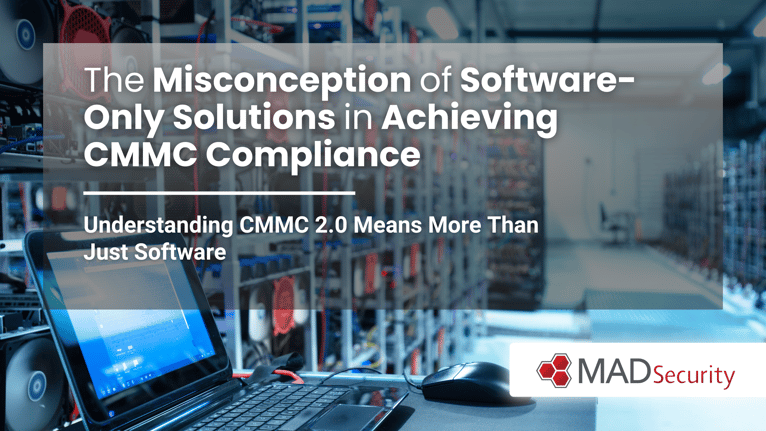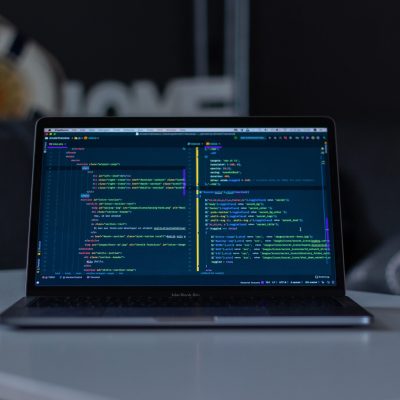
In the rapidly evolving world of cybersecurity, the Cybersecurity Maturity Model Certification (CMMC) 2.0 stands as a beacon of robust security protocols, especially for organizations working with the Department of Defense (DoD). As a leading Managed Security Services Provider (MSSP), MAD Security emphasizes that while software plays a critical role in achieving compliance, relying solely on it is a misconception. This article delves into why purchasing software is not a complete solution for meeting CMMC requirements and what organizations should focus on instead.
Understanding CMMC 2.0: More Than Just Software
CMMC, a framework set by the DoD, outlines a comprehensive set of cybersecurity practices and processes. It is designed to protect Controlled Unclassified Information (CUI) within the Defense Industrial Base (DIB). The CMMC model integrates various cybersecurity standards, primarily NIST SP 800-171, and is divided into three different levels, each with its specific requirements.
The first misconception many organizations face is assuming that compliance is a checkbox activity, solvable by merely implementing new software solutions. However, CMMC’s emphasis on continuous cyber hygiene and organizational adaptation to evolving threats necessitates a more holistic approach.

- Lack of Customization in Off-the-Shelf Compliance Software
Off-the-shelf compliance software may offer a generic set of tools and controls designed to meet broad requirements, but it often lacks the capability to adapt to the unique cybersecurity landscape of each organization. The CMMC framework necessitates a nuanced approach, as it encompasses various maturity levels and control sets that need to be applied based on the specific type of Controlled Unclassified Information (CUI) an organization handles and the particular cyber threats it faces.
Specifically, the issues with lack of customization include:
- Inability to Address Unique Risks: Every organization has its own risk profile based on its business model, size, and the nature of its government contracts. A standardized software package cannot tailor its risk assessment and mitigation strategies to these individual characteristics.
- Inflexible Control Implementation: CMMC requires a specific set of practices and processes that must be implemented in the context of an organization’s existing IT infrastructure. Pre-packaged software may not offer the flexibility to integrate with or adjust to bespoke systems or proprietary technologies.
- Regulatory Mismatch: Depending on the level of CMMC certification desired, an organization may be subject to a range of specific regulatory requirements. Generic software may not cover all these bases, potentially leaving critical compliance gaps.
- Human Element Overlooked by Compliance Software
Cybersecurity is fundamentally a human-centric endeavor. While software can enforce certain rules and automate processes, the human element – including employee behavior, knowledge, and response to incidents – is paramount.
In detail, overlooking the human element can lead to:
- Compliance Culture: Building a culture of compliance is essential for CMMC adherence. Software can support this culture, but it cannot create it. Leadership must drive home the importance of cybersecurity, and this cultural shift cannot be automated.
- Insufficient Security Training: Software cannot replicate the nuanced and dynamic training required to keep employees informed about the latest cybersecurity practices and threats.
- Poor Incident Response: In the event of a security breach, human intervention is crucial. Employees must be equipped to respond appropriately, and software alone cannot make the critical decisions required in a dynamic incident response scenario.

- Dynamic Nature of Threats Unmatched by Static Software
Cyber threats are dynamic and sophisticated, often outpacing the rate at which software updates are released. A static software solution will invariably fall behind the curve of evolving threats.
This dynamic nature requires:
- Continuous Threat Intelligence: Software must be complemented with ongoing threat intelligence to anticipate and respond to new and emerging threats.
- Adaptive Security Postures: Organizations need to be able to adapt their security postures quickly. This requires flexible systems that can be updated in real-time, something that a static software package may not support.
- Innovative Defense Strategies: As attackers employ increasingly sophisticated methods, defense strategies need to be equally innovative. This often requires a blend of technologies, human expertise, and strategic planning that goes beyond software capabilities.
- Software Integration Challenges
Software solutions, especially when sourced from multiple vendors, can present significant integration challenges, leading to a disjointed security environment.
Specific integration challenges include:
- Complex Management: A multi-software environment can complicate the management and oversight of the cybersecurity framework, increasing the administrative burden and the potential for oversight errors.
- Incompatible Systems: Different software systems may use incompatible data formats or communication protocols, making seamless integration difficult.
- Data Silos: Without proper integration, critical data might become siloed within different tools, impeding a unified view of the organization’s security posture.
- Overemphasis on Tools Over Strategy
A tool-centric approach to compliance may lead organizations to overlook the strategic aspects of cybersecurity.
The pitfalls of this approach include:
- Compliance vs. Security Confusion: There’s a difference between being compliant and being secure. While tools can help with compliance, they do not guarantee security. A strategic approach ensures that compliance efforts actually contribute to a stronger security posture.
- Neglected Policies and Procedures: Effective cybersecurity strategies are underpinned by strong policies and procedures. These are the frameworks within which tools operate, and without them, tools cannot be effectively employed.
- Strategic Blind Spots: By focusing on tools, an organization may develop blind spots in areas that software does not address, such as insider threats or the physical security of systems.

While compliance software is an essential component of the CMMC compliance journey, it should not be viewed as a standalone solution. A comprehensive, strategic approach that integrates People, Processes, and Technology is necessary to ensure not only compliance with CMMC but also a robust cybersecurity defense against the evolving landscape of cyber threats.
A Holistic Approach to CMMC Compliance
When pursuing CMMC compliance, organizations should take a comprehensive approach that involves People, Processes, and Technology. This multifaceted strategy is not just about meeting regulatory requirements; it’s about establishing a resilient cybersecurity infrastructure that can adapt to changing threats and protect sensitive information.
People: The First Line of Defense
Training and Awareness: Regular training and awareness programs for employees are vital. People should understand their role in maintaining cybersecurity and be updated on the latest security practices and threats.
- Benefit: Regular training ensures that employees are not just passive participants in cybersecurity but active defenders against threats. Awareness programs create a knowledgeable workforce that can recognize and respond to security incidents promptly.
- Outcome: A well-trained staff can reduce the risk of security breaches caused by human error, ensure better compliance with security protocols, and can act quickly to mitigate threats when they occur.
Skilled Cybersecurity Team: Having a team of experts who understand the nuances of CMMC and can implement and manage the necessary controls is crucial.
- Benefit: A dedicated team of cybersecurity experts ensures that CMMC practices are not only implemented but also managed and adapted over time. These professionals bring a depth of knowledge about both the CMMC framework and the broader cybersecurity landscape.
- Outcome: Having such a team in place leads to a robust security posture, where compliance is continuously monitored and improved, and the organization stays ahead of cyber threats.
Processes: The Backbone of Compliance
Risk Assessment and Management: Regularly assessing and managing risks, and tailoring security controls to address identified vulnerabilities is at the heart of CMMC.
- Benefit: By regularly assessing and managing risks, organizations can proactively identify vulnerabilities and implement appropriate controls before they are exploited.
- Outcome: This proactive approach not only secures the organization against known risks but also prepares it to deal with unforeseen challenges, ensuring business continuity.
Documentation and Policy Development: Developing and maintaining comprehensive security policies, procedures, and documentation is essential for demonstrating CMMC compliance.
- Benefit: Well-developed policies and procedures ensure that all employees understand their roles and responsibilities in maintaining security. Documentation provides a clear roadmap for compliance and is essential for audits and assessments.
- Outcome: Comprehensive documentation leads to a culture of accountability and transparency, which can significantly improve the organization’s security and compliance stature.

Technology: The Enabler, Not the Sole Solution
Appropriate Software Selection: While software is crucial, it should be chosen based on a thorough understanding of specific requirements and how it fits into the broader security ecosystem.
- Benefit: Selecting the right software based on specific CMMC requirements ensures that Technology supports the People and Processes involved in maintaining cybersecurity.
- Outcome: The right software solutions can streamline compliance efforts, automate security tasks, and provide real-time monitoring and alerts, thus enhancing the organization’s overall security framework.
Regular Updates and Maintenance: Continuously update and maintain software to ensure it aligns with current threats and compliance requirements.
- Benefit: Keeping software up-to-date is essential to protect against the latest threats and maintain compliance with current CMMC standards.
- Outcome: Regular updates and maintenance lead to a resilient IT environment where potential vulnerabilities are patched promptly, reducing the risk of breaches and ensuring ongoing compliance.
Implementing the Holistic Approach
Integrating People, Processes, and Technology: Integrating people, processes, and technology is about creating a synergistic cybersecurity environment where each element strengthens the other, ensuring a robust defense against threats and compliance with CMMC requirements.
- Benefit: When people, processes, and technology work together seamlessly, organizations can create a dynamic and responsive cybersecurity ecosystem.
- Outcome: This integration results in a robust security posture that aligns with strategic business objectives, supports compliance, and fosters a secure operational environment.
Continuous Improvement Cycle: The continuous improvement cycle embodies the ongoing process of evaluation, refinement, and enhancement of cybersecurity practices to maintain a state of perpetual readiness and alignment with CMMC standards.
- Benefit: A holistic approach to CMMC compliance isn’t static; it involves an ongoing process of assessment, improvement, and adaptation.
- Outcome: Organizations that embrace continuous improvement can quickly adapt to changes in the cybersecurity landscape, maintaining a state of readiness and resilience.

A holistic approach to CMMC compliance leads to a stronger, more secure organization that is better equipped to protect sensitive information. This strategy not only meets regulatory requirements but also embeds cybersecurity into the very fabric of the organization’s culture and operations.
Conclusion: Opt for a Strategy-Centric Approach with MAD Security
To truly safeguard your operations and achieve CMMC compliance, it’s clear that software, while crucial, cannot function in isolation. What sets successful organizations apart is a comprehensive strategy-first approach—one that MAD Security champions. We bring a bespoke blend of People, Processes, and Technology meticulously tailored to align with your organization’s unique needs. At MAD Security, our mission is to escort your business through the intricate maze of cybersecurity challenges, providing not just a path to CMMC compliance but fortifying your defenses to be as resilient as possible. Partner with us and gain more than compliance; secure a future where your cybersecurity framework is designed to be an unyielding fortress.
Original Published Date: December 19, 2023
By: MAD Security

